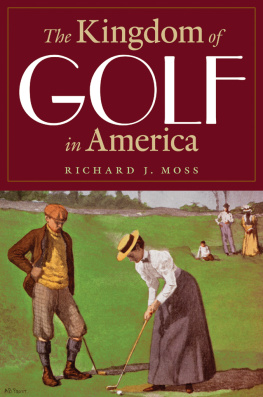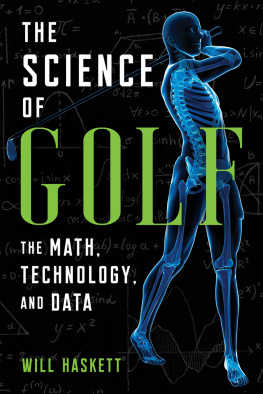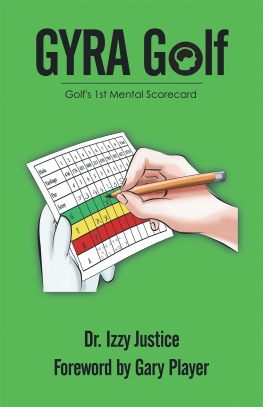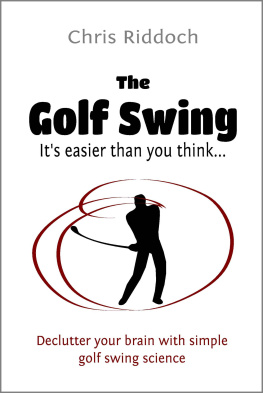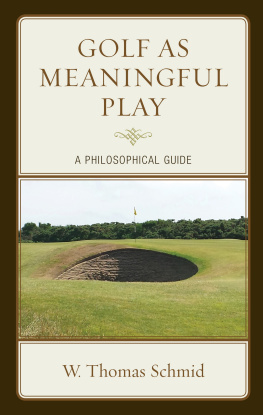

2013 by Richard J. Moss
All rights reserved
Manufactured in the United States of America
Library of Congress Cataloging-in-Publication Data
Moss, Richard J.
The kingdom of golf in America / Richard J. Moss.
p. cm.
Includes bibliographical references and index.
Epub ISBN 978-1-4962-1105-7
MOBI 978-1-4962-1106-4
1. Golf United States
History. 2. Golf Social aspects United States. 3. United States
Social life and customs. I. Title.
GV 981. M 67 2013
796.3520973 dc23 2012047430
Set in New Baskerville by Laura Wellington.
The publisher does not have any control over and does not assume any responsibility for author or third-party websites or their content.
Acknowledgments
This book is the product of a long life in golf and a scholarly life that turned out better than I deserved.
I grew up in Jackson, Michigan, a great golf town. Much of what I have said in this book is shaped by my early life in a town that took golf very seriously. Teaching pros Chuck Smith and Ken Douglas gave free lessons. There were courses on which I could play all day for fifty cents. People for whom I caddied passed on free balls, paid my way to tournaments, and became range buddies. One older gentleman, in particular, convinced a callow teenager that the game posed philosophical, even religious, questions. After that I could never think of golf as merely a silly game.
At Michigan State University Douglas Miller and Russel B. Nye allowed me to think seriously about the history of popular culture. In recent years several individuals have eagerly provided support and the best sort of criticism. Bradley S. Klein of Golfweek has made this book better in countless ways. His thoughtful readings of this and earlier manuscripts have been invaluable. Orin Starn and Jim Dodson have provided encouragement and have served as examples of people who take golf seriously. I owe a considerable debt to the United States Golf Association. Research into the history of golf would have been virtually impossible without access to their library and research services provided on the Internet. The most immediate guardian of the collection, Nancy Stulack, has been unfailingly helpful on numerous occasions. The USGA has also conducted a series of symposiums at which I was allowed to try out ideas and at which I learned much from other historians. I would like to thank David Normoyle, once at the USGA and now on his own, for his friendship and for the discussions of golf that helped me sort out what I actually believed. I also need to thank my wife, Jane, for her bottomless patience with my golf obsession and my desire to write books about it. Family friends Pearl Rose and Georgia Katz have been there when I needed them.
My fondness and respect for reference librarians is boundless. At Colby College and at Duke University these selfless souls invariably understood my vague needs and directed me to the resources, often obscure, which are central to this book. Sarah P. Ward was a pal and the best person to translate my scrawl into a workable manuscript. Karen Brown was my dream copyeditor; she sanded off a lot of junk and made the remainder shine.
It has been my privilege to be a regular on a golf discussion show on WEEB Radio in Moore County, North Carolina. The others on the show John Derr, Pat McGowan, Tom Stewart, Rich Mandell, and the creator of the show, Les Fleischer have created a neat little world where the game is taken seriously every week. On the show I have had a chance to listen to smart people like Ben Crenshaw and Richard Coop talk about golf from their own extensive experience. Being part of the show has deepened and widened my perspective on the game.
I have played golf with thousands of people over the last sixty years and I have learned something from each of them. My play in the scrambles at Waterville Country Club in Maine and in the Monday Group and the Tuesday Golf Society at Pinehurst has profoundly enlivened my sense of what the game means to people. From this vast group of golfers let me dedicate this book to two of them. Let it be a small tribute to Dale Brown and Tim ODay, princes in the kingdom.
Introduction
My once-or-twice-a-week golf games have been islands of bliss in my life, and my golfing companions, whose growing numbers now include a number of the dead, are more dear to me than I can unembarrassedly say. Somehow, it is hard to dislike a man once you have played a round with him. John Updike, The Bliss of Golf, 1982
Golf has always been a part of my life. There once existed a photo of me, now lost, taking some of my first steps aided by my fathers hickory-staffed brassie. I cannot remember a time when I did not care about how I was playing and when I would play next. In the last fifty years I have developed a profound fondness for a number of golf courses, both public and private. I feel more comfortable on a golf course than I do in my own bed.
So I find it difficult to think of golf as a hobby, a diversion, or a consumer choice. I do not like the idea that I am a small part of a big sport industry. Golf is not a commodity unless you think it is. Golf, as I have experienced and studied it, is a physical and mental place to be in other words, a community.
I have tested this idea with some of my fellow golfers. The question put to them was, do you feel like you belong to a golf community? As an academic playing golf with nonacademics, I am subject to considerable suspicion when I ask such questions. Most, however, readily agree that they belong to a golf community. Most belong to a private club or have a membership at a public course, and this obviously creates a sense of community, a sense of belonging. One went further and called this community the kingdom of golf. In this kingdom you are, he said, restrained by a set of rules and traditions. You are provided a slowly growing set of heroes. The kingdom has a founding, a history, internal divisions (parties), and a generally agreed-upon set of values. The official language is English but with a highly specialized vocabulary that can bewilder noncitizens. Obviously, the golf community offers several levels of citizenship. There are those who care deeply and make golf one of the most vibrant parts of their lives. There are many who only occasionally pass through the kingdom transients of a sort. Oddly, there are those who watch others play but do not play themselves. Like all communities, the kingdom of golf has a hierarchy. It has developed a politics with leaders who claim the authority to protect and regulate the game. They pass laws that provide order in the kingdom. These laws generate controversy and are not always obeyed.
Finally, the golf community has a literature. It is a complex pile. At the bottom are national, regional, and local magazines. They began to appear almost as soon as golf, the game they chronicle, began to be played in America. They convey news and opinion; they do much to hold the community together. As we get nearer the top of the pile, golf literature gets more literary and philosophical. Works on heroes and great moments are common. At the very top are a small number of works that attempt to define the games essence and to place it within the larger history of sport and the nation.
This book is a history of the golf community in the United States. This history began in the 1880s and continues, of course, to the present. For 130 years, the kingdom has waxed and waned in response to larger historical currents. In the most general sense, the people who founded the golf community were responding to modernization. By modernization, I mean a set of forces that arose most clearly after the Civil War. For golf, the most important forces were urbanization and suburbanization operating in tandem. By 1890 Americans were confronted with what might be called the new city. Golf was part of the adjustments that Americans (mostly affluent) made to the new city. The rise of the new city eroded the sense of community that most had felt prior to 1870. It also detached them from nature and plunged them day after day into a rapidly declining cityscape. Golf was just one of the many ways that people sought to reconstitute community, to revive a sense of belonging. It was also one way that Americans sought to reconnect with nature.
Next page
